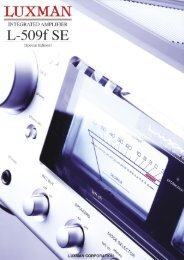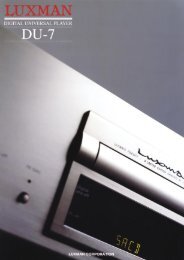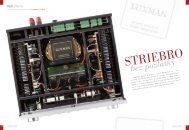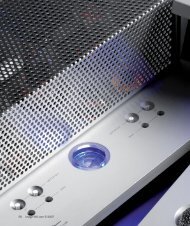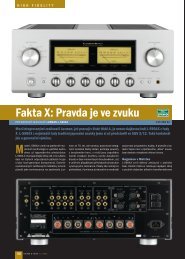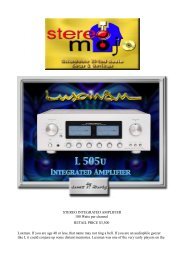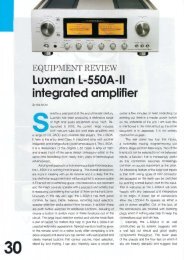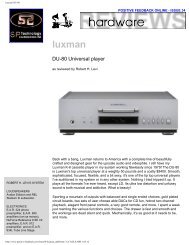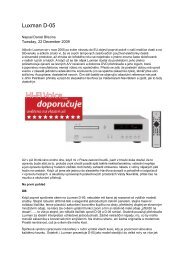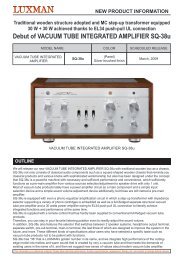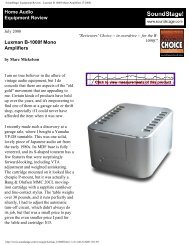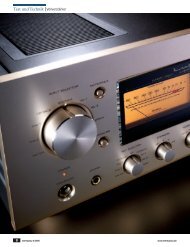Luxman L-509u test / SoundStage!
Luxman L-509u test / SoundStage!
Luxman L-509u test / SoundStage!
You also want an ePaper? Increase the reach of your titles
YUMPU automatically turns print PDFs into web optimized ePapers that Google loves.
<strong>Luxman</strong>’s importer, Philip O’Hanlon of On a Higher Note. Because the tracks were from different<br />
artists and albums, recorded at different levels, I had to compensate with some tracks and adjust the<br />
volume. No big deal.<br />
The unit that had been sent to me by O’Hanlon had significant use prior to my evaluation; therefore, no<br />
burn-in was required and it performed flawlessly with no hiccups. Most of my evaluation was done<br />
using the L-<strong>509u</strong> with the tone controls defeated. I did also, on occasion, take advantage of the line-in<br />
option to drive the amplifier section using my Wadia 830 CD player’s digital volume control (and<br />
remote control!). Although the unit never got more than warm, even with extended use at high SPLs, I<br />
would still recommend having sufficient airspace over the top to provide adequate ventilation.<br />
Sound<br />
Like the Esoteric A-100 I reviewed, the L-<strong>509u</strong> was one dead-quiet integrated amp with an ultra-low<br />
noise floor, resulting in the blackest of backgrounds from which the music would emerge in solid,<br />
focused, three-dimensional images. Additionally, the L-<strong>509u</strong> was tonally neutral, and did not favor one<br />
end of the frequency spectrum over another; instead its sonic signature was geared toward delivering the<br />
least-colored, most musically natural performance, regardless of the type of music. Although a class-AB<br />
integrated amp, the L-<strong>509u</strong> likely runs in class A more than most integrateds at similar power outputs<br />
and volumes, resulting in this natural, distortion-free quality. The music was so natural-sounding and<br />
involving that I found myself listening more to the music than to the usual recorded artifacts that I often<br />
pay attention to when evaluating a component. Its ability to make me forget about what I was doing and<br />
just enjoy the music did wonders for increasing sheer musical pleasure, but at the expense of interfering<br />
with my ability to focus on and get down to the job at hand: reviewing the thing!<br />
Associated Equipment<br />
Loudspeakers – Wilson Audio Sophia.<br />
Integrated amplifier – Jeff Rowland Design<br />
Concentra.<br />
Digital – Wadia 830 CD player, Logitech<br />
Transporter wireless DAC, Apple MacBook<br />
with 1TB Apple Time Capsule.<br />
Interconnects – Transparent Audio Ultra<br />
MusicLink.<br />
Speaker cables – Transparent Audio Ultra<br />
MusicLink.<br />
Headphones and Headphone amplifier –<br />
Sennheiser HD 600 headphones, Ultimate<br />
Ears UE 11 Pro in-ear monitors, Ray<br />
Samuels Audio Emmeline, The Predator<br />
headphone amp.<br />
Accessories – Audio Power Industries<br />
Power Pack II.<br />
Dynamically, the L-<strong>509u</strong> was a solid performer, capable<br />
of wide swings in volume with no compression or<br />
congestion at louder volumes. A favorite classical<br />
recording of mine is of Seiji Ozawa conducting the<br />
Boston Symphony Orchestra’s performance of<br />
Stravinsky’s Petrouchka (BMG Classics 09026-63311-2).<br />
This rhythmic, fanfare-like composition is a great workout<br />
for integrated amps and can lack coherence when rendered<br />
through lesser components. The L-<strong>509u</strong> handled this<br />
composition with aplomb and without any sense of strain,<br />
and the transient response, particularly with strings and<br />
brass, was fast. With regard to soundstaging, most<br />
amplifiers perform best at realistic volumes, with the<br />
soundfield collapsing at lower volumes. However, the L-<br />
<strong>509u</strong> delivered soundstaging that was stable, broad and<br />
deep, even at low-level SPLs, and blossomed even further<br />
when the speakers were given more juice.<br />
Very impressive was the reproduction of high frequencies<br />
and the midrange. On "Azalea" from trumpeter Brian<br />
Lynch’s album 24/7 (Nigel Hayer 2055), Lynch solos on<br />
his trumpet with the band playing softly behind him, and<br />
little details, such as the crisp high hat or the faint brushes<br />
on the snare heard in the background, sounded light and<br />
delicate, while still remaining detailed. Lynch’s playing in the upper register was smooth, airy, and<br />
graceful, floating front and center, with no evidence of hardness or edge. The low noise floor of the L-<br />
<strong>509u</strong> again contributed to unveiling this low-level detail.



